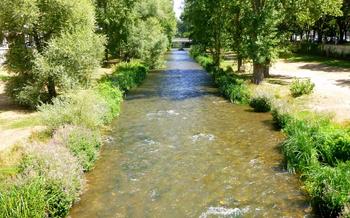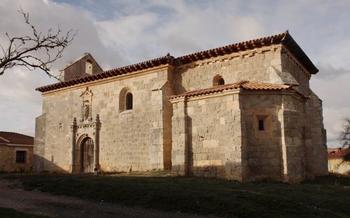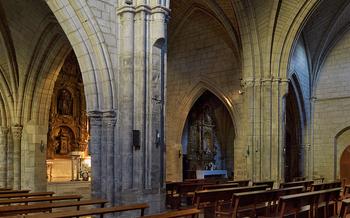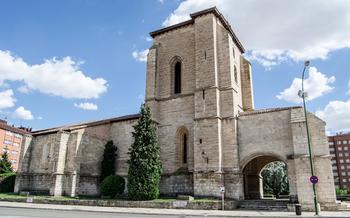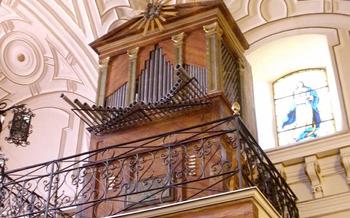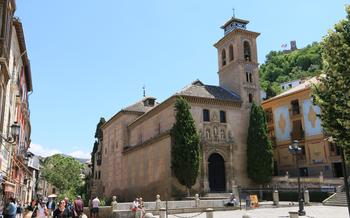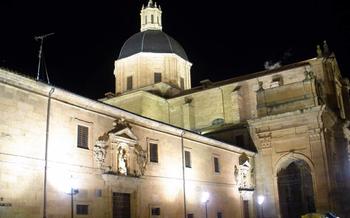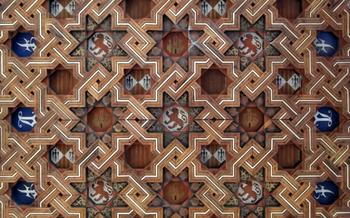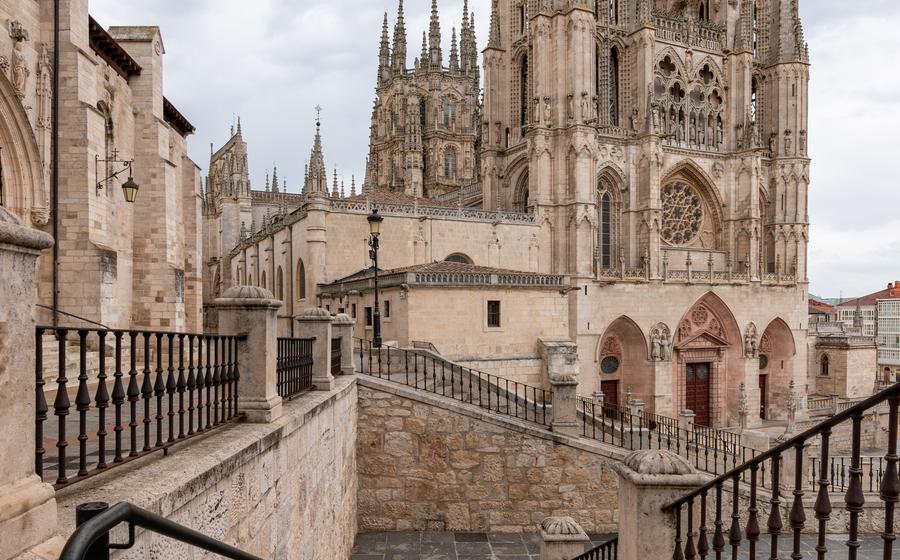
Catedral de Burgos
- Catedral de Burgos: A Masterpiece of Gothic Architecture
- Exploring the Exterior:
- Stepping Inside the Cathedral
- The Altarpieces: A Showcase of Artistic Mastery
- The Tomb of El Cid:
- The Cloister: A Serene Oasis within the Cathedral
- Gothic Arches and Intricate Carvings
- Role in Monastic Life
- Tranquility and Beauty
- The Chapel of Santa Ana: A Hidden Gem
- The Sacristy: A Repository of Sacred Treasures
- Guided Tours: Unveiling the Cathedral's Secrets
- Admission and Timings:
- Accessibility
- Insider Tip: Unveiling the Enchanting Essence of Catedral de Burgos
Catedral de Burgos: A Masterpiece of Gothic Architecture
The Catedral de Burgos stands as a magnificent testament to the power and artistry of the Gothic style. Its construction began in 1221 under the reign of King Ferdinand III of Castile and was completed in 1567, spanning over three centuries of architectural innovation. The cathedral is renowned for its exceptional beauty, intricate details, and harmonious proportions, earning it the designation as a UNESCO World Heritage Site.
The cathedral's history is intertwined with the city's religious and cultural heritage. Burgos, once the capital of the Kingdom of Castile, was a thriving center of commerce and pilgrimage. The construction of the cathedral was a collective effort, driven by the contributions of skilled craftsmen, architects, and patrons who sought to create a monumental structure that would reflect the city's grandeur and devotion.
The influence of the Gothic style is evident throughout the cathedral's design. The soaring vaults, pointed arches, and ribbed ceilings create a sense of height and grandeur, while the intricate carvings and sculptures that adorn the facade and interior showcase the artistry and craftsmanship of the period. The cathedral's stained-glass windows, with their vibrant colors and intricate patterns, bathe the interior in a celestial glow, adding to its spiritual atmosphere.
Exploring the Exterior:
The Catedral de Burgos boasts an awe-inspiring exterior that showcases the intricate details and grandeur of Gothic architecture. As you approach the cathedral, take a moment to admire its imposing facade, adorned with elaborate sculptures, carvings, and moldings. The intricate portal carvings depict biblical scenes and figures, each telling a story from the Bible. Look closely at the flying buttresses, which support the cathedral's walls and lend it a sense of lightness and elegance. Take your time to walk around the cathedral, admiring the different perspectives and architectural features that make it unique. Don't forget to climb to the top of the surrounding hills for a breathtaking panoramic view of the city and the cathedral, which dominates the skyline.
Stepping Inside the Cathedral
Venturing into the interior of the Catedral de Burgos is a journey through time and art. Marvel at the soaring vaults that reach towards the heavens, supported by slender columns that create a sense of awe-inspiring grandeur. Light streams through the magnificent stained-glass windows, casting a kaleidoscope of colors that illuminate the cathedral's interior. Admire the intricate details of the choir stalls, where intricate carvings depict scenes from the Bible and the lives of saints. Step into the Capilla del Condestable, a masterpiece of Renaissance architecture, and learn about its historical significance as the burial place of illustrious figures. Explore the chapels and side altars dedicated to various saints, each adorned with unique artistic treasures that tell stories of faith and devotion.
The Altarpieces: A Showcase of Artistic Mastery
The Catedral de Burgos is home to a stunning collection of altarpieces, each a masterpiece of artistic craftsmanship and religious devotion. These elaborate structures, adorned with intricate carvings, delicate paintings, and gilded ornamentation, serve as focal points within the cathedral's grand interior.
One of the most notable altarpieces is the High Altar, a breathtaking spectacle that dominates the chancel. Created by the renowned sculptor Gil de Siloé, the High Altar is a masterpiece of late Gothic style, featuring an intricate arrangement of carved figures, delicate tracery, and vibrant colors. The central panel depicts scenes from the life of Christ, while the flanking panels showcase a multitude of saints and biblical figures.
Another highlight is the Altarpiece of the Transfiguration, located in the Capilla del Condestable. This stunning work of art, attributed to the painter Alonso de Sedano, depicts the biblical scene of Jesus' transfiguration on Mount Tabor. The vibrant colors and expressive figures create a sense of awe and wonder, inviting the viewer to contemplate the divine nature of this miraculous event.
The Altar of Saint Anne, situated in the Chapel of Santa Ana, is a masterpiece of Renaissance art. Created by the sculptor Diego de Siloé, this elegant altarpiece features a delicate composition of carved figures arranged around a central panel depicting the Virgin Mary with the infant Jesus and Saint Anne. The intricate details and harmonious proportions of this altarpiece exemplify the transition from Gothic to Renaissance aesthetics.
These altarpieces are not mere decorative elements; they are profound expressions of faith and artistic mastery. Each altarpiece tells a story, conveying religious messages and inspiring devotion among the faithful. They serve as a testament to the enduring power of art to uplift the spirit and connect us to the divine.
The Tomb of El Cid:
In the heart of the Catedral de Burgos lies the final resting place of a legendary figure whose name echoes through the annals of Spanish history: El Cid, the national hero of Spain. Born Rodrigo Díaz de Vivar, El Cid's exploits during the Reconquista, the centuries-long struggle to reclaim the Iberian Peninsula from Muslim rule, earned him a place among the most revered figures in Spanish history.
Within the Chapel of the Constable, visitors can pay homage to El Cid's memory as they stand before his elaborate tomb. The tomb, adorned with intricate carvings and inscriptions, serves as a testament to the hero's life and legacy. Here, visitors can learn about El Cid's role in the Reconquista, his unwavering loyalty to his king, and his enduring significance to the city of Burgos.
The Chapel of the Constable, with its Gothic architecture and ornate details, provides a fitting backdrop for El Cid's tomb. As visitors gaze upon the tomb, they are transported back in time to a period of great upheaval and heroism, when El Cid's bravery and leadership helped shape the destiny of a nation.
The Cloister: A Serene Oasis within the Cathedral
Amidst the grandeur and opulence of the Catedral de Burgos, a hidden gem awaits discovery—the cloister. Step into this tranquil haven, a serene oasis that invites you to escape the bustling city and immerse yourself in a world of peace and tranquility.
Gothic Arches and Intricate Carvings
The cloister's serene atmosphere is enhanced by its exquisite Gothic architecture. Admire the graceful arches that frame the courtyard, their delicate tracery reaching towards the heavens. Gaze upon the intricate carvings that adorn the capitals, each one a masterpiece of craftsmanship, telling tales of saints and biblical scenes.
Role in Monastic Life
In medieval times, the cloister played a vital role in the life of the cathedral's monks. It served as a place for quiet contemplation, prayer, and study. Here, the monks would gather to discuss religious matters, share meals, and tend to the needs of the community.
Tranquility and Beauty
Today, the cloister continues to offer solace and tranquility to visitors seeking a respite from the busy world outside. Stroll along the covered walkways, marveling at the intricate details of the architecture and the peaceful ambiance that surrounds you. Let the beauty of this hidden gem transport you to a simpler time, where contemplation and spirituality prevailed.
The Chapel of Santa Ana: A Hidden Gem
Amidst the grandeur of the Catedral de Burgos, a hidden gem awaits discovery: the Chapel of Santa Ana. This exquisite Renaissance masterpiece is tucked away within the cathedral's walls, revealing a treasure trove of artistic and historical significance.
Built in the 16th century, the Chapel of Santa Ana is a testament to the architectural prowess of the Renaissance era. Its intricate details, from the elegant arches to the delicate carvings, showcase the transition from Gothic to Renaissance styles. The chapel's serene atmosphere invites visitors to pause and admire its beauty, a stark contrast to the grandeur of the main cathedral.
The chapel holds a special place in the history of Burgos, as it was commissioned by the Catholic Monarchs, King Ferdinand and Queen Isabella. The chapel served as their private oratory, a place where they could seek spiritual solace amidst the demands of their reign.
The chapel's interior is adorned with stunning frescoes, vibrant stained-glass windows, and intricate carvings that depict scenes from the life of Saint Anne, the mother of the Virgin Mary. The altar features a beautiful altarpiece dedicated to Saint Anne, showcasing the skill and artistry of the Renaissance masters.
Despite its smaller size compared to the main cathedral, the Chapel of Santa Ana holds its own in terms of artistic and historical value. It is a hidden gem that offers visitors a glimpse into the transition from Gothic to Renaissance architecture and the personal devotion of the Catholic Monarchs.
The Sacristy: A Repository of Sacred Treasures
The sacristy of the Catedral de Burgos is a treasure trove of sacred objects and artifacts that hold immense religious and historical significance. Within its walls, visitors can discover a remarkable collection of reliquaries, liturgical vestments, and precious objects that have been meticulously preserved over the centuries.
These sacred items, intricately crafted from gold, silver, and precious stones, showcase the exceptional artistry and craftsmanship of past generations. Reliquaries, adorned with delicate filigree and enamel work, house the relics of saints and martyrs, revered figures in the Catholic faith. Liturgical vestments, such as chasubles, dalmatics, and copes, are adorned with intricate embroidery and opulent fabrics, reflecting the grandeur of religious ceremonies.
The sacristy also houses a collection of chalices, ciboria, and monstrances, meticulously crafted from precious metals and adorned with gemstones. These sacred vessels are used in the celebration of the Eucharist, a central rite in Catholic liturgy.
Visitors to the sacristy can gain a deeper understanding of the history and significance of these sacred treasures through informative displays and guided tours. These tours provide insights into the rituals and traditions associated with the use of these objects, shedding light on the deep spiritual and cultural heritage of the Catedral de Burgos.
Guided Tours: Unveiling the Cathedral's Secrets
Enhance your visit to the Catedral de Burgos by joining a guided tour, an excellent way to delve deeper into its history, architecture, and significance. Knowledgeable guides, passionate about the cathedral's heritage, will captivate you with fascinating stories and anecdotes, bringing the cathedral's past to life. Tours can be customized to focus on specific aspects that interest you, such as the cathedral's Gothic architecture, its artistic masterpieces, or its role in the city's religious and cultural life. With a guided tour, you'll gain a richer understanding and appreciation for this architectural marvel, making your visit truly unforgettable.
Admission and Timings:
Planning your visit to the Catedral de Burgos is essential to make the most of your experience. The cathedral's admission fees vary depending on the level of access you desire. A standard ticket grants you entry to the main cathedral, while a combined ticket includes access to the museum, cloister, and other restricted areas.
Opening hours may vary throughout the year, so it's advisable to check the cathedral's official website or contact the tourist information center for the most up-to-date information. The cathedral is generally open to visitors daily, with slightly shorter hours on Sundays and holidays.
To avoid the crowds and enjoy a more tranquil experience, consider visiting during off-peak hours, such as early in the morning or late in the afternoon. Keep in mind that the cathedral may be closed for special events or religious ceremonies, so it's worth checking the calendar before your visit.
For those seeking a deeper understanding of the cathedral's history and significance, guided tours are available in various languages. These tours provide fascinating insights into the architecture, artwork, and religious significance of this magnificent edifice.
Accessibility
The Catedral de Burgos is committed to providing an inclusive and accessible experience for all visitors. Wheelchair access is available through the main entrance, and ramps and elevators are strategically placed throughout the cathedral to ensure easy movement for those with mobility limitations. Visitors with visual or auditory impairments can request assistive devices such as audio guides or tactile models to enhance their experience. The cathedral staff is well-trained and ready to assist visitors with any accessibility needs, ensuring a comfortable and enjoyable visit for everyone.
Insider Tip: Unveiling the Enchanting Essence of Catedral de Burgos
To fully immerse yourself in the captivating ambiance of Catedral de Burgos, venture beyond the architectural marvels and explore the hidden gems that await. Attend a classical music concert or a religious ceremony held within the cathedral's hallowed halls. The acoustics of this sacred space transform every note into a celestial symphony, creating an ethereal atmosphere that will leave you spellbound. As the music reverberates through the centuries-old walls, you'll feel transported to a realm where the divine and the earthly intertwine.
After your musical or spiritual journey, step into the nearby Plaza Mayor, the vibrant heart of Burgos. This bustling square exudes a distinctly Spanish charm, with its lively atmosphere, colorful buildings, and inviting outdoor cafes. Indulge in a delectable meal at one of the many restaurants lining the plaza, savoring the local flavors and soaking in the sights and sounds of this dynamic city. As you relish the moment, you'll realize that the true essence of Catedral de Burgos extends far beyond its architectural wonders, encompassing the cultural tapestry and vibrant spirit of the city itself.
